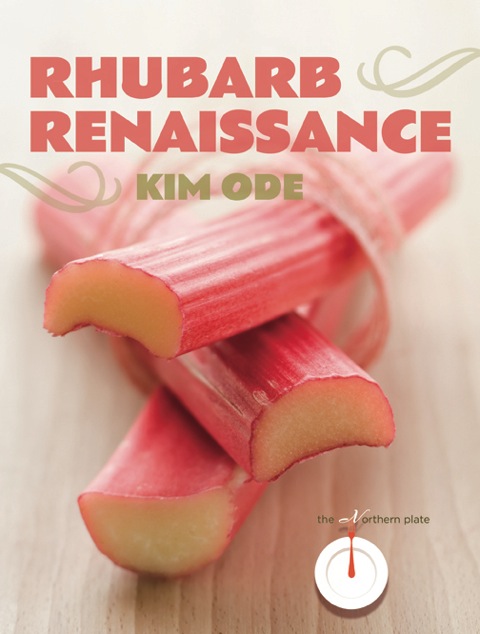“What I really like about Ode's book is that once you get past the counterintuitive feeling of "You can't do that with rhubarb," you realize that the recipes are very simple, do-able extensions of how people really cook, just taking better advantage of a local vegetable.” -- Dara Moskowitz Grumdahl on Minnesota Public Radio

I should have known better.
My cousin’s seemingly casual invitation was too intent on success, the gleam in her eye a bit too bright. “Take a bite,” she said, holding out the stalk of rhubarb.
She spoke as if she were postponing her own pleasure, as if her bite of the scarlet stalk could wait if it meant her own dear young cousin could be happy. The rhubarb looked tasty. The pale green stalk looked like celery, but better, with brilliant red striations that caught the sunlight. The bottom knob of the stalk, where it had been pulled from the plant with a firm tug, appeared as polished as marble. This knob was pink, as pink as the hollyhocks against my Grandma Torkelson’s house. It was a shade of pink that, yet today, makes me smile. But it was the other end, where the great leaf had been lopped off by my beguiling cousin, that revealed the stalk’s pale green interior. “Take a bite,” she said again.
To a child’s fairly untested taste buds, rhubarb is a shock. The initial crunch is quickly replaced by the sensation of every pore in your mouth constricting in the face not so much of a taste that is sour—although your brain is screaming “Sour!”—as in the realization that spitting out the rhubarb risks releasing even more of its barbarity and that, while ridding yourself of this morsel now is more important than anything you’ve ever done, the specter of tasting more rhubarb, even on its way out, is akin to realizing that someone’s nails are only halfway down the blackboard.
In short, this drama is great good fun for the proferrers of rhubarb and an unforgettable experience for those who, against all of their instincts, finally take a bite.
The good news is that we know now that kids’ taste buds are especially sensitive to bitter or sour flavors and that maturity brings the joy of realizing that rhubarb is one of the great delights of horticulture. Sadly, some people never move beyond that childhood trauma. They believe rhubarb is practically inedible unless buried in vast quantities of sugar. That’s one reason rhubarb most often ends up in desserts.
Many of the recipes in this cookbook also explore the far side of the culinary world—a landscape where rhubarb regains its stature as a vegetable, providing a piquant accompaniment to grilled meats and succulent fish and seafood and perfectly complementing the richness of cheese. Rhubarb pickles are a revelation in salads. A cheese strudel brightens with a smear of savory rhubarb mostarda. And wait until you taste what happens when you pair rhubarb with shrimp.
In short, it’s time for rhubarb to shed its image as a sugar-swathed pie plant and find a place at our tables as an appetizer, cocktail, salad, side dish, and entrée—while also remaining one of the best desserts around.
Here’s what people are saying about “Rhubarb Renaissance.” Media link page




